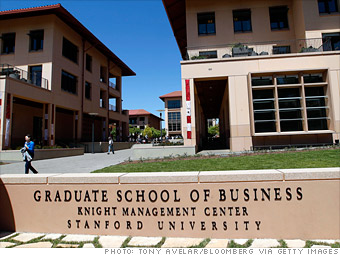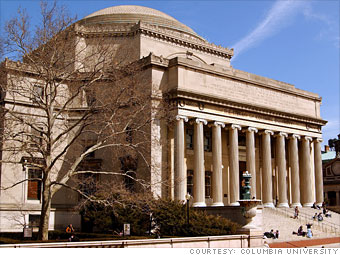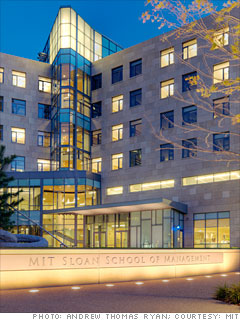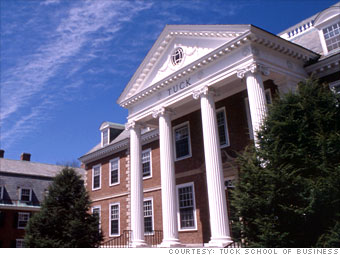Which schools have the best job placement records and strongest programs? Here's this year's Poets&Quants ranking of the best of the best MBA programs in the U.S.
Index: 100
2010 Rank: 1
Average GMAT: 727
Acceptance rate: 12%
Median base salary: $120,000
Suggested two-year budget: $168,000
When people think about the MBA degree, the very first school that immediately springs to mind is Harvard. HBS is synonymous with the degree and literally sets the pace for the industry. It's why everything it does instantly makes news -- both good and bad. And Harvard's new dean, Nitin Nohria, has immediately injected new energy and enthusiasm at the school.
Within 12 short months since assuming leadership of HBS last July 1, Nohria has racked up accomplishments that would have taken some B-school deans a decade or more. They include crafting and then communicating a new agenda for the school, pushing through significant changes to the MBA program amid concerns from some that he was moving too fast, and raising millions of dollars in donations, including a $50 million gift from India's Tata Group and its philanthropic interests.
Percentage of MBAs with job offers at graduation: 94%
Index: 98.8
2010 Rank: 2
Average GMAT: 730
Acceptance rate: 12%
Median base salary: $125,000
Suggested two-year budget: $174,362
Stanford Graduate School of Business has been on a roll this past year. The school moved into a new, classy home, an ambitious $350 million campus composed of nine world-class buildings. And the school just received $150 million from an alum -- its largest gift ever -- to help establish a new institute whose goal is to combat poverty around the world. But the school's main attraction is its location in the midst of Silicon Valley, the world's high tech center. Many graduates end up working for startups and the Valley's giants, from Apple and Google, to Hewlett-Packard and Intel, or starting their own companies from scratch. Stanford's first-year Management Foundation courses offer students a menu of choices in each required discipline, tailored to their skills, experience, and career goals. Stanford students also have the option to incorporate courses -- and especially joint degrees -- from other graduate programs at the university.
Percentage of MBAs with job offers at graduation: 84%
3. Booth - Univ. of Chicago
Index: 98.5
2010 Rank: 3
Average GMAT: 719
Acceptance rate: 22%
Median base salary: $107,000
Suggested two-year budget: $170,976
The mantra of the University of Chicago Booth School of Business is it's all about the idea. Students focus on generating, analyzing, comparing and refining ideas so they can turn them into even better ones.
The full-time MBA Program consists of 20 classes plus leadership effectiveness and development (LEAD). The flagship of the program is its flexible curriculum. With only one required course, students design a program to fit their career goals.
Four major components make up the flexible curriculum: foundation courses that focus on developing analytical tools and knowledge that support the rest of the curriculum; functions, management, and business environment courses that cover basic disciplines, management, and the environment in which firms operate.
Percentage of MBAs with job offers at graduation: 86%
Index: 98.0
2010 Rank: 4
Average GMAT: 720
Acceptance rate: 19%
Median base salary: $120,000
Suggested two-year budget: $178,400
A new MBA curriculum now delivers life-long education to MBA graduates, along with more leadership and communication experiences. The basic program is still focused around an intensive core curriculum in general management, plus the depth of 18 majors and the breadth of nearly 200 electives.
The school's month long pre-term session includes a two-day off-campus retreat where students begin the process of learning to lead in a team environment. The first year's focus is an intensive core curriculum that students complete together in learning teams of six.
During the summer months between the first and second years, students are busy with internships, career treks, and volunteer projects around the world. When they return, the second year curriculum offers flexibility to follow personal interests.
Percentage of MBAs with job offers at graduation: 88%
5. Columbia
Index: 95.0
2010 Rank: 5
Average GMAT: 716
Acceptance rate: 16%
Median base salary: $110,000
Suggested two-year budget: $165,740
In the provocative documentary Inside Job, which chronicles the origins of the global financial crisis of 2008, Columbia Business School endures a nasty beating due to its close and cozy alignment with Wall Street.
Dean Glenn Hubbard, who had been chief economic adviser during the Bush administration, and finance professor Frederic Mishkin, a member of the Board of Governors at the Federal Reserve from 2006 to 2008, both nearly make fools of themselves.
No matter. If you're headed into financial services, you'll be hard pressed to find a more direct route than Columbia, which probably has more alumni on Wall Street than any other business school in the world (Wharton and NYU also are good bets but even they don't exactly rival Columbia).
Percentage of MBAs with job offers at graduation: 86%
Index: 95.0
2010 Rank: 8
Average GMAT: 710
Acceptance rate: 13%
Median base salary: $119,000
Suggested two-year budget: $165,264
MIT Sloan's two-year MBA Program is comprised of a combination of case studies, team projects, lectures, live case discussions, interactions with industry leaders, and hands-on lab classes.
Throughout the first-semester core, students work in teams of five or six, gaining skills through required coursework in economics, accounting, managerial communication, business statistics, and organizational processes.
Only one semester long, the short core gives students freedom to pursue individual goals throughout the rest of the program.
7. Kellogg - Northwestern
Index: 94.9
2010 Rank: 7
Average GMAT: 714
Acceptance rate: 20%
Median base salary: $110,000
Suggested two-year budget: $162,458
"Think Bravely: We believe that business can be bravely led, passionately collaborative, and world changing."
Those 15 words are at the heart of an ambitious effort to reposition Northwestern University's Kellogg School of Management. The phrase is part of a branding exercise that will lead to more substantive changes at Kellogg by new Dean Sally Blount.
The school is known for its highly collaborative culture, its team-based approach to learning, and an unrivaled marketing faculty. For years, before several other schools caught up, Kellogg MBAs were known as a group with the emotional intelligence and interpersonal skills that set them apart from others. Bount is hoping to make Kellogg entirely distinctive again.
Percentage of MBAs with job offers at graduation: 86%
Index: 93.6
2010 Rank: 6
Average GMAT: 718
Acceptance rate: 18%
Median base salary: $110,000
Suggested two-year budget: $168,100
Tuck's unique, close-knit culture of affection and collaboration cultivates such unusual loyalty that more than 70% of alumni last year reached into their pockets to support the school, more than any other B-school in the world. (In contrast, annual alumni giving at the top 20 business schools average less than 20%).
Tuck's highly supportive alumni network helped to get 92% of this year's class job offers by graduation -- tops among the best B-schools in a still turbulent economy.
Dean Paul Danos takes little credit for the remarkable cohesion among alumni through the years. "You can't invent the love affair people have with Tuck," he says. "That whole cultural, social network of helping each other you can't get easily, and it's always been a part of the school's tradition."
Percentage of MBAs with job offers at graduation: 92%
Index: 92.3
2010 Rank: 9
Average GMAT: 715
Acceptance rate: 12%
Median base salary: $111,000
Suggested two-year budget: $156,284 (non-resident)
The highly selective MBA program at the Haas School of Business is anchored by 12 required courses that promote a general-management perspective and provide a framework for the more function-specific courses that follow.
The first year of the program is divided into four quarters. The core curriculum is rooted in business fundamentals -- including marketing, finance, and accounting.
Berkeley Innovative Leader Development (BILD) is a connective theme that runs through the entire MBA curriculum to ensure that every student develops leadership skills.
Percentage of MBAs with job offers at graduation: 77%
Index: 91.6
2010 Rank: 10
Average GMAT: 698
Acceptance rate: 26%
Median base salary: $107,833
Suggested two-year budget: $143,718
The first term at the Fuqua School of Business focuses on the development of collaborative leadership and organizational management skills. The full-time MBA program begins with a three-week Global Institute featuring two core courses: Leadership, Ethics and Organizations; and Global Institutions and Environments.
Students then dive into economics, finance, marketing, and operations management.
Throughout the program, students can pursue a wide-ranging management education designed to suit their individual goals; alternatively, they have the option to focus on a particular career path through a variety of interdisciplinary concentrations and certificate opportunities.










I saw this article and I think that it is great and very informative but here are some of my thoughts and questions. What about the people that cannot afford to go to those schools? All of these schools cost over a $150,000 for a 2-year MBA program and clearly you went to at least a 4-year program for your Bachelors degree. Now you are around $250,000-$300,000 in debt, right after graduation. How long will it take to pay those student loans off? I ask. If you are one of the lucky ones and fall within the 70% being offered a job right after graduation, will you still get paid enough to cover your student loans? Perhaps. But how many years will it take to pay those student loans? and How much will you pay in interest over those years? I have a very strong feeling that your student loan debt will at least have doubled by the time you are done paying it. I am speaking from experience, since I am a recent college graduate, who has received letters from the lenders, stating exactly how long it will take to pay for my loans and how much will I end up paying. Yes, student loans are like buying a house at 18, that you do not start living in until you are well over 25. My issues with tuition costs are very simple. If we want to go to a prestigious school and have a decent job, or even a job, after graduation, then how are we supposed to go on in life? We are already in debt at 25, that does not even include mortgage, car payment, insurances, credit cards, and so on.
ReplyDeleteThinking about higher education in usa , study in usa Engineering in usa,mba in usa , graduation in usa contact Abroad education consultants , Gurgaon at 8802888895 for expert guidance on studying in usa.
ReplyDelete